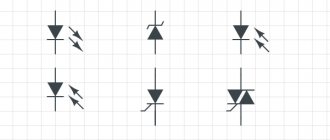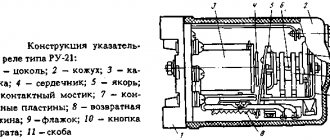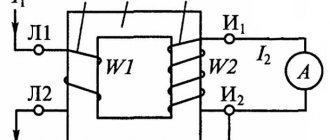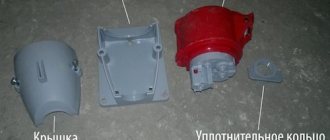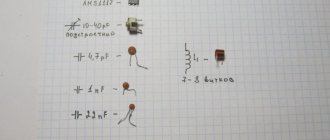Operating principle of RCD
An RCD or residual current device is a device necessary to open an electrical circuit in the event of a differential current leak.
During normal operation of the electrical network and electrical equipment, the potential difference in the cables is zero. However, if there is a breakdown in the insulation or another malfunction in the electrical circuit, a differential current leaks, which is supplied to the device body. And by touching the body, a person himself becomes a conductor (a differential current passes through his body), risking electrical injury. The RCD monitors the potential difference and when it forms, it instantly breaks the circuit, turning off the electricity in the entire apartment or only in a certain area. It is worth noting that the residual current device does not protect wiring and household appliances from voltage surges and short circuits in the network - this is done by circuit breakers. Therefore, RCDs should be installed in conjunction with circuit breakers, connecting them in series.
What is differential current?
The differential current is the sum of the leakage current and the ground fault current.
If a RCCB is installed, then the differential current is the difference in current between the phase and neutral currents of the RCCB.
Officially (GOST is the same, clause 3.2.3): differential current is
“the effective value of the vector sum of currents flowing in the primary circuit of the RCCB.”
Thus, the differential current IΔ, which can trigger the RCCB, will be the sum of two components: leakage current and ground fault current. It is never zero because the “background” leakage current is always present. And it can increase sharply if a ground fault current appears.
Power calculation for RCD
Each individual device has its own threshold current load, at which it will operate normally and will not burn out. Naturally, it should be higher than the total current load of all devices connected to the RCD. There are three types of RCD connection diagrams, each of which has its own calculation of the device’s power:
- A simple single-level circuit with one protection device.
- Single-level circuit with several protection devices.
- Two-level shutdown protection circuit.
Calculating power for a simple single-level circuit
A simple single-level circuit is characterized by the presence of one RCD, which is installed after the meter. Its rated current load must be higher than the total current load of all consumers connected to it. Suppose the apartment has a boiler with a capacity of 1.6 kW, a washing machine with a capacity of 2.3 kW, several light bulbs with a total capacity of 0.5 kW and other electrical appliances with a capacity of 2.5 kW. Then the current load calculation will be as follows:
(1600+2300+500+2500)/220 = 31.3 A
This means that for this apartment you will need a device with a current load of at least 31.3 A. The closest RCD in terms of power is 32 A. It will be enough even if all household appliances are turned on at the same time.
One such suitable device is the ERA NO-902-126 VD63 RCD, designed for a rated current of 32 A and a leakage current of 30 mA.
We calculate the power for a single-level circuit with several protection devices
Such a branched single-level circuit assumes the presence of an additional bus in the meter device, from which wires depart, forming separate groups for individual RCDs. Thanks to this, you can install several devices on different groups of consumers or on different phases (with a three-phase network connection). Typically, a separate RCD is installed on the washing machine, and the remaining devices are installed for consumers, which are formed into groups. Suppose you decide to install an RCD for a washing machine with a power of 2.3 kW, a separate device for a boiler with a power of 1.6 kW, and an additional RCD for the rest of the equipment with a total power of 3 kW. Then the calculations will be as follows:
- For a washing machine - 2300/220 = 10.5 A
- For a boiler - 1600/220 = 7.3 A
- For other equipment - 3000/220 = 13.6 A
Taking into account the calculations, for this branched single-level circuit, three devices with a power of 8, 13 and 16 A will be required. For the most part, such connection schemes are applicable for apartments, garages, temporary buildings, etc.
By the way, if you don’t want to bother too much with installing such a circuit, then pay attention to portable RCD adapters that can quickly switch between sockets. They are designed for one electrical appliance.
Calculating power for a two-level circuit
The principle of calculating the power of a residual current device in a two-level circuit is the same as in a single-level circuit, with the only difference being the presence of an additional RCD located at the entrance to the apartment, before the meter. Its rated current load must correspond to the total current load of all devices in the apartment, including the meter. Let us note the most common RCD indicators for current load: 4 A, 5 A, 6 A, 8 A, 10 A, 13 A, 16 A, 20 A, 25 A, 32 A, 40 A, 50 A, etc.
An RCD at the input will protect the apartment from fire, and devices installed on separate groups of consumers will protect a person from electric shock. This scheme is the most convenient in terms of repairing electrical wiring, as it allows you to disconnect a separate section without disconnecting the entire house. Also, if cable systems need to be repaired at an enterprise, you won’t have to shut down all office premises, which means there won’t be massive downtime. The only disadvantage is the considerable cost of installing an RCD (depending on the number of devices).
If you are already registered, enter your login information!
Previous article Next article
RCD residual current device (description, purpose, connection diagram)
Residual current device (abbreviated RCD) more precise name: residual current device controlled by differential (residual) current - a mechanical switching device, which, when the differential (residual) current reaches (exceeds) a given value, should cause the contacts to open.
The main task of an RCD is to protect people from electric shock and from fire caused by current leakage through worn wire insulation and poor-quality connections.
Combined devices that combine an RCD and an overcurrent (short circuit) protection device are also widely used; such devices are called RCD-D with built-in overcurrent (short circuit) protection, or simply a diffavtomat. Often differential automatic devices are equipped with a special indication that allows you to determine for what reason the operation occurred (from overcurrent or differential current).
Point by point it looks like this:
1.Increasing the level of safety when people use household and similar electrical appliances;
2.Prevention of fires due to fire of insulation of live parts of electrical appliances from differential (residual) current to the ground;
3. (for diffavtomats) Automatic shutdown of a section of the electrical network (including residential) in case of overload (TZ-current protection) and short-circuit current (MTZ-maximum current protection).
NOTE: In Russia, the use of RCDs became mandatory with the adoption of the 7th edition of the Electrical Installation Rules (PUE). (The seventh edition was prepared by JSC VNIIE. Approved by order of the Ministry of Energy of the Russian Federation dated 07/08/02 No. 204. Entered into force on 01/01/03 . )
Typically, in the case of household electrical wiring, one or more RCDs are mounted on a DIN rail in the electrical panel.
LET'S SUM UP THE FIRST SHORT RESULT:
There are two types of residual current devices on sale:
1. Directly RCD.
2. And RCD-D (differential) is an RCD + short circuit circuit breaker in “one package”.
One more thing! Attention!
The use of an RCD is an additional protective measure, and not a replacement for protection against overcurrents using fuses, since the RCD does not react in any way to faults if they are not accompanied by current leakage (for example, a short circuit between the phase and neutral conductors). Therefore, the RCD must be used together with Circuit Breakers (fuses)
An RCD can significantly improve the safety of electrical installations, but it cannot completely eliminate the risk of electric shock or fire. The RCD does not respond to emergency situations unless they are accompanied by a leak from the protected circuit. In particular, the RCD does not respond to short circuits between phases and neutral.
The RCD will also not work if a person is under voltage, but no leakage has occurred, for example, when a finger touches both the phase and neutral conductors at the same time. It is impossible to provide electrical protection against such touches, since it is impossible to distinguish the flow of current through the human body from the normal flow of current in the load. In such cases, only mechanical protective measures are effective (insulation, non-conductive casings, etc.), as well as disconnecting the electrical installation before servicing it!
Now let's look at the characteristics of the RCD indicated on the facade of the device.
RCDs are designed to protect a person from electric shock through indirect contact (person touching open, non-current-carrying parts of an electrical installation that are energized in the event of insulation damage), as well as direct contact (person touching live parts of an electrical installation that are energized). This function is provided by an RCD of appropriate sensitivity (cut-off current no more than 30 mA (milliamps).
Note: In the United States, the National Electrical Code requires ground fault circuit interrupters (GFCIs) intended to protect people to operate at 4 to 6 mA (milliamps) of current (the exact value is selected by the device manufacturer and is typically 5 mA) for a time of no more than 25 ms (microseconds). In Europe, these values for RCDs, like ours, are 30-100 mA.
RCDs should be triggered in no more than 25-40 ms (milliseconds), that is, before the electric current passing through the human body causes cardiac fibrillation - the most common cause of death from electric shock.
The table below shows the current values through the human body and the most likely sensations.
Note: Do not try to experience this for yourself!
| Current through the body | Feeling | Result |
| 0.5 mA | Not felt. Weak sensations
| Safely. |
| 3 mA | The sensation is close to an ant bite. | Not dangerous. |
| 15 mA | If you grab the conductor, it is impossible to let go of it. | Unpleasant, but not dangerous. |
| 40 mA | Body spasms, diaphragm spasms. | Danger of suffocation within a few minutes. |
| 80 mA | Vibration of the heart ventricle. | Very dangerous, leads to fairly quick death. |
Hence the second short summary:
To protect people in household electrical networks (single-phase current with a voltage of 220 volts)
RCDs must be marked: cut-off current no more than 30 mA, response time no more than 40 ms (milliseconds)
Large manufacturing companies (such as ABB, Legrand) produce RCDs for human protection with cut-off currents of 10 mA and 30 mA.
An RCD with a current of 30 mA is usually installed on group circuits. If you install a 10 mA RCD, false alarms are possible (there is always a background, natural leakage current in the apartment). 10 mA is usually installed on single consumers (machine, stove). If you have a shower stall, or a washing machine is installed in a humid environment, the use of an RCD with a cut-off current of 10 mA is simply necessary.
It should be repeated: For wet and very wet rooms (saunas, baths, baths, showers) an RCD with a leakage current of 10 mA (milliamps) should be used.
For other premises, it is sufficient to use an RCD with a cut-off current of 30 mA (milliamps)
In wooden buildings, when carrying out electrical wiring, in order to avoid fires, installing an RCD is desirable, or better yet, simply necessary.
Note: There are RCDs on sale with cut-off drains of 100mA and 300mA and more. These RCDs (with residual currents of 100mA, 300 mA and more are sometimes used to protect large areas of electrical networks (for example, in computer centers), where a low threshold would lead to false alarms.Such low-sensitivity RCDs perform a fire-fighting function and are not effective protection against electric shock.
Now let us note a number of other points. In accordance with the classification, RCDs are divided into:
Type AC is an RCD whose tripping is guaranteed if the differential sinusoidal current either suddenly appears or increases slowly.
Type A is an RCD whose tripping is guaranteed if a sinusoidal or pulsating differential current either suddenly appears or slowly increases.
Third result:
Type A is more expensive and more versatile, but both types are excellent for use in household electrical networks. Therefore, there is no need to focus on this.
RCDs of the AC type are mainly widely sold (only the icon will be depicted on the facade of the device:
It is necessary to pay attention that each RCD is designed for use in networks of a certain load, namely a certain Amperage, which is indicated on the facade of the RCD. Since RCDs in electrical networks are used together with circuit breakers (fuses), I draw your attention once again: the amperage of the RCD should be higher than the machine on the line.
Now let’s look at the circuit diagram for connecting an RCD using classic grounding (TN-C). Classic grounding is the majority of houses in the Russian Federation; in these houses in apartments there is no separate dedicated grounding line, that is, two, not three, wires run throughout the apartment. Another electrical diagram of houses This is called electrical wiring with separate neutral and protective conductors (TN-S). I will talk about this connection, as well as errors that occur when connecting several RCDs, in the next article.
Before connecting the RCD, I pay attention to how the RCD circuit works. The operating principle of the RCD is based on a comparison of the output (going into the apartment) and input (returning from the apartment) current. If it turns out that the balance is disturbed and less comes in than goes out, then the RCD turns off the power supply. If the RCD is installed for one line, then there are two options: install an automatic machine after the RCD, or the device itself must have a built-in maximum current limiter. Connecting an RCD without a circuit breaker will lead to the fact that a short circuit or constant overheating can damage it. Let me remind you: the amperage of the RCD must be higher than that of the machine on the line.
The RCD connection diagram looks like this:
NOTE: Connecting the power wires at the top is just a tradition. It is this, and not some technical reason, that determines the recommendation for connecting from above. And, although from a safety point of view, it would be better to connect everywhere the same way, there is no strict prohibition on connecting from below. However, it is highly desirable that within the shield, and even better, throughout the entire facility, power is supplied equally: either from above (everywhere) or from below (everywhere).
Well, that’s probably all I wanted to tell you about the RCD (Residual Disconnect Device) in household electrical networks with a voltage of 220 volts. In the next article in the ELECTRICAL section I will talk about connecting the RCD in networks with separate neutral and protective conductors (TN-S), and also about errors that occur when connecting several RCDs.
Successful endeavors, everyone!
Previous article Next article
How to calculate an RCD for a house and apartment
To calculate a residual current device (RCD), it is necessary to take into account its operating conditions. In a single-phase electrical network, two-pole devices are used, and in a three-phase electrical network, four-pole devices are used. Since the RCD reacts to leakage currents (Iut), its choice will depend on the length of the conductors, the quality of the insulation, the number of connected devices, devices, and their characteristics. In addition, we must remember that Iut of 30 mA can be dangerous to human life. Therefore, in wet rooms it is necessary to install an RCD.
Where is it necessary to install an RCD in the electrics of an apartment and house?
According to our regulatory documents, the RCD is an additional protection device. (PUE ed. 7, clause 1.7.50; clause 1.7.156).
Optional does not mean optional.
Installation of RCDs is carried out in all groups of the electrical circuit in which plug sockets are installed. The rated shutdown current of the device should be no more than 30 milliamps. At least one general Protective Disconnection Device for the entire apartment (house) must be installed.
If you have an electrical network with many power supply groups, installing an RCD for each group together with a common RCD will only improve the safety of the living space. It is allowed to install one RCD on several separate power supply groups, provided that separate circuit breakers are installed on each group.
In damp areas of an apartment or house where sockets are installed (bathrooms, kitchens), as well as in separate electrical lines supplying household appliances that work directly with water (washing machine, dishwasher), you need to install an RCD with a cut-off current of 10 mA.
You should not install RCDs in electrical networks that directly supply household appliances, such as air conditioners. Such devices have an internal protection system. The device for such devices will most likely trigger falsely.
Installation of RCDs in 4-wire three-phase electrical networks (TN-C diagram). About grounding systems, read a separate article: Grounding systems TN, TT, TN-C, TN-S, TN-CS and IT.
Leakage current
To ensure safety from electric shock, it is often necessary to increase the number of residual current devices and divide the network into several groups. At the same time, the use of very sensitive RCD devices leads to false alarms. The specialist’s task is to make the correct calculation and choice, taking into account all factors.
According to the rules of electrical installations, when Iut is unknown, it is taken equal to the product of 0.4 mA by the number corresponding to the calculated load current in amperes. The circuit leakage is assumed to be equal to the product of 0.01 mA by the length L of the phase conductor in meters.
According to the same rules, the total network losses must be less than one third of the rated residual current of the RCD. This also includes all leaks from constantly switched on and periodically connected electrical appliances. Let's do the calculation.
Total Iut= 0.4* IΣ +0.01*L
It follows that the maximum current of the RCD must be 3 times greater than the total Iout of the network.
Accordingly, the rated breaking current is equal to:
IΔn= 3*(0.4* IΣ +0.01*L), where
IΣ – total leakage current of all electrical installations in the network,
L is the length of the phase wire in meters.
Calculation of circuit breaker and residual current device (RCD)
How is a circuit breaker calculated?
Correct calculation of the circuit breaker plays a very important role.
The power calculation of the machine is carried out if the wires along the entire length in all sections of the electrical wiring are designed for such a load. The determining value for choosing the rated current of the machine is the cross-section of the current-carrying wire.
For example, the permissible current for a copper wire with a cross-section of 1.5 kW. mm, is 19 amperes. This means that for this wire we select the closest value of the rated current of the machine to the smaller side, which is 16 amperes. If you select a machine with a value greater, the wiring will heat up.
To select the cable cross-section and rated current of the machine, you need to calculate the expected load. This calculation is made by summing up the power of the devices that will be connected to the site. The total power will determine the current flowing through the wiring.
Formula I=P/U
Next, use the reference tables to select the appropriate wire cross-section. This takes into account the method of laying and the material of the conductor.
The next step is to select a machine that will be installed in the electrical panel.
It is not difficult to calculate the number of machines for a house or apartment yourself.
You just need to follow certain rules:
Knowing the load current, the wire cross-section is selected to be larger, and the circuit breakers are selected according to the lower current.
The input AB is calculated and limited by the power allocated to your facility. The number of machines is calculated based on the number of electrical wiring lines and consumers.
The calculation must be made carefully, since your life and the safety of material assets depend on it. Therefore, it is better to entrust the calculation to qualified specialists.
Table for selecting a machine based on the power of electrical appliances:
Table for selecting a cable to Auto off / Differential auto / RCD
How to calculate a residual current device (RCD)
In practice, it is not always possible to accurately calculate the total leakage current. It is approximately determined by the following method: for 1 A of consumed load, take 0.4 mA of current leakage.
You should also make a calculation based on the length of the phase wire - 10 μA is taken per 1 m
Example: RCD for the power of an electric stove (3 kW)
First, we calculate its load:
3000 W / 220 V = 13.64 A. Leakage current for the stove: 13.64 A x 0.4 mA = 5.46 mA. We perform the same calculation for a laid conductor, for example, 10 m: 10 µA x 10 m = 100 µA = 0.1 mA. In total, the leakage current is: 5.46 mA + 0.1 mA = 5.56 mA.
The resulting value of the sum of current leakage should not exceed 33% of the differential rated current of the RCD. Next we make up an elementary proportion and get: 5.56 mA x 100% / 33% = 16.85 mA.
Choice for an apartment
For an example of calculation, let's take an apartment in a multi-story building. There is a circuit breaker in the floor panel at the input. Let the machine be 40 Ampere. It protects against short circuits and overloads. A fire protection RCD is installed immediately behind it; we will calculate its nominal value later.
It is needed for fire protection in case of cable insulation failure or breakdown. Further, to ensure greater safety and uninterrupted supply of electricity, RCDs with a certain Iout from 10 to 30 mA are installed for each or several groups. Depends on leakage currents.
There are even sockets with their own RCD devices. Each consumer group is equipped with its own automatic overload switch.
The bathroom has a washing machine with a power of 1.8 kW. Since it is located in a damp room, for safety we will provide a 16 A circuit breaker and calculate the RCD based on power.
The operating current for a washing machine is:
The length of the phase wire to it is 20 m.
Hence IΔn= 3*(0.4* IΣ +0.01*L)=3(0.4x7.3+0.01x20)=9.36 mA.
The closest RCD in the row is 16 A, leakage current 10 mA.
RCD installation
- The device is installed after overcurrent protection circuit breakers.
- It is recommended to install the device in such a way that the phase and neutral working conductors are disconnected at the same time. In this case, the installation of an overcurrent protection circuit breaker on the neutral wire is not necessary.
- The visual diagrams below show the correct and incorrect connections of the device in the apartment and house.
- In the top diagram, the device is installed immediately after the electric meter, without a circuit breaker. This is unacceptable (PUE 7.1.76).
It is impossible to install human protection against leakage currents in group circuits where there is no protection against overcurrents. On the source side, you need to install an overcurrent protection circuit breaker (ECP) in front of it.
Rated current
The RCD has another important parameter - the rated current, which must be taken into account in the calculations. When operating within the nominal limits, the device is guaranteed to perform its functions for as long as desired.
Overload protection circuit breakers, which are installed on each power supply group, have a rating of 16, 20, 25, 32 amperes, and so on. But when these values are reached, the device will not turn off.
Its characteristics are such that it begins to turn off at values exceeding the nominal value by 1.13-1.45 times, only thanks to the thermal release. It turns off after one to two hours. And for a quick shutdown, it needs to exceed the nominal value from three to fifteen times. This feature of the overload and short circuit protection circuit breaker must be taken into account.
The disconnect device is installed with a rated current always at a level higher . For example, if there is a 32 ampere circuit breaker for overloads and short circuits, then the residual current device should be 40 amperes.
Therefore, in the apartment for which the calculation was made, the fire-fighting RCD device will have a rated shutdown current of 100 mA and 63 A, respectively. The washing machine will have a 10 mA/16 A device. For the second lighting group, there will be a device with a limit of 10 mA/25 A. The remaining RCD devices have limits of 30 mA/32 A.
additional characteristics
In addition to these basic characteristics for which calculations are carried out, there are also quantities that require attention when choosing. This is the maximum short circuit current; for a home it is assumed to be 4500 A, for an apartment building 6000 A, for production 10000 A. On the body of the product it is depicted as a number surrounded by a frame. The type of disconnecting leakage current is indicated by letters:
- AC means it is variable;
- A – IΔn variable and pulsating constant;
- B – IΔn variable and constant;
- S – selective, turns off with a delay.
RCD type AC is used in apartments. Common consumers - lighting, refrigerators, heated floors. The maximum shutdown time for this type of RCD is 0.04-0.3 seconds, depending on the magnitude of the leakage current.
Type A is used where there are many devices with rectifiers and switching power supplies: computers, washing machines, televisions, dishwashers, microwave ovens. Sometimes manufacturers directly indicate that there should be an RCD A device, and then a current calculation is performed.
Type B is used mainly in industry, requiring detailed calculations before installation.
Type S (selective). The response time of such an RCD is 0.2-0.5 seconds, so it is not protective for humans. The device is installed at the beginning of the line after the main circuit breaker and is the second stage of differential protection of the entire facility from fire.
In addition, you need to determine which residual current device to choose: electromechanical or electronic. The first is more reliable, but also more expensive. The second type is cheaper than electromechanical, but its electronic components more often burn out under all kinds of overloads.
When organizing an electrical network protection system, it is necessary to take into account that more than 5 circuit breakers cannot be connected to one RCD. This may lead to false positives. In addition, with proper shutdown, it is impossible to understand where the leak occurred.
Characteristics of the residual current device
Your health and, possibly, your life will depend on how correctly you choose a protection device. That is why this issue must be approached with full responsibility. What are the characteristics of RCDs , which also have another name - differential switches (not to be confused with automatic machines)?
- Differential current. Main parameter of the device. Essentially, this is the sensitivity of the protection system. For example, the differential switch shown below will trip if there is a leak of 30 mA (position 3 in the photo).
- Operating current or power. Current load in amperes that the device can withstand for a long time without damage or overheating (position 1).
- Operating voltage. The maximum voltage of the network into which the RCD will be built (position 2).
- Type of tension. The type of network voltage into which the protection device will be built. Can be variable, constant or variable + constant (position 5).
Purpose of RCD and principle of operation
It is important to understand that this device protects against excess current, and not against voltage surges and short circuits. At the same time, a circuit breaker protects the electrics in the house, and a residual current device can reduce the risk of electric shock.
The RCD is not designed to protect against short circuits, so it is imperative to connect a circuit breaker to it. Before deciding which RCD to choose, you need to know its design and operating principle.
There are several coils located inside the housing. One coil is connected to the phase, the other to the neutral wire. Current passing through the coils creates magnetic fields. Since they are directed in opposite directions, they destroy each other. If the current passing through one of the coils is stronger than it should be, then an excess field is formed, which directs it to the third coil. When the third coil starts working, the RCD protection is activated as intended and turns off the electricity in this area of the house.
Based on the principle of operation of the device, the question of how to choose the right RCD for a house or apartment is resolved.
How to choose the right RCD according to parameters
The choice of RCD must be carried out, paying attention to its rated and differential operating current.
Rated is the current for which the power contacts are designed. If it increases, they may fail. Differential is the operating current of the residual current device, that is, leakage.
Before choosing an RCD, it is useful to find out its price, quality and performance and compare these three parameters. Since choosing an RCD based on power and quality can be difficult for a non-professional, experts advise making a table of the parameters of the devices you like and using it to select a device with the best characteristics.
Rated current
When selecting by rated current, you need to know that the device is always placed in series with a circuit breaker to protect power contacts from overload and short circuit. If one or the other occurs, the device does not work, since it is not intended for this. Therefore, it must be protected automatically.
The next thing you should pay attention to: the rated current must at least match that declared for the machine, and it is better to be 1 step higher.
Differential current
There are two important things to remember here:
- For electrical safety purposes, a differential operating current of either 10 mA or 30 mA is always selected. For example, you can install a 10 mA RCD on one electrical receiver. At the entrance to the house, a device with this value may operate too often, since the electrical wiring in the apartment has its own leakage limits.
- All other RCDs with a differential current above 30 mA are used for fire protection purposes. But when installing a 100 mA RCD at the input, a 30 mA RCD must be installed in series with it for electrical safety purposes. In this case, it would be advisable to install a selective RCD at the input so that it operates with a short time delay and allows a device with a lower rated current to operate.
Product type
According to the form of current leakage, all these devices are classified into 3 types:
- “AC” type device. This device is common due to its more affordable price. Triggers only when a sinusoidal current leak occurs.
- Device type “A”. Designed to operate upon the instantaneous or gradual appearance of excess current, which has a variable sinusoidal and pulsating constant shape. This is the most popular type, but has an increased cost due to the ability to control both constant and variable flow.
- Type “B” device. Most often used to protect industrial premises. In addition to responding to sinusoidal and pulsating shapes, it also responds to the rectified shape of a constant leak.
In addition to these main three types, there are 2 more:
- Selective device type “S”. It does not turn off immediately, but after a specified period of time.
- Type "G". The principle is the same as the previous one, but the shutdown time is slightly shorter.
Design
By design, there are 2 types of RCDs:
- electronic – operating from an external network;
- electromechanical – independent of the network; no power is needed for its operation.
RCD without ground
Method of connecting an RCD without protective grounding
Section 7.1.80, quoted at the beginning, does not exist in splendid isolation in the PUE. It is supplemented with points explaining how (well, there are no grounding loops in our houses, no!) to “shove” an RCD into the TN-C system. Their essence boils down to the following:
- It is unacceptable to install a general RCD or a circuit breaker in an apartment with TN-C wiring.
- Potentially dangerous consumers must be protected by separate RCDs.
- The protective conductors of sockets or socket groups intended for connecting such consumers must be connected to the INPUT zero terminal of the RCD in the shortest possible way, see the diagram on the right.
- Cascade activation of RCDs is allowed, provided that the upper ones (closest to the electrical input RCDs) are less sensitive than the terminal ones.
A smart person, but unfamiliar with the intricacies of electrodynamics (which, by the way, many certified power electricians are guilty of) may object: “Wait, what’s the problem? We install a common RCD, connect all PEs to its input zero - and you’re done, the protective conductor is not switched, we are grounded without a ground!” Yes, but not so.
The PE segment with the corresponding zero segment and the equivalent consumer resistance R form a loop encircling the magnetic circuit of the differential transformer, see the operating principle of the RCD-D. That is, a PARASITIVE winding appears on the magnetic circuit, loaded at R. Although R is small (48.4 Ohm/kW), on a sine wave of 50 Hz the influence of the parasitic winding can be neglected: the radiation wavelength is 6000 km.
We also exclude the electromagnetic field of the installation and the cord to it from consideration. The first is concentrated inside the device, otherwise it will not pass certification and will not go on sale. In a cord, the wires pass close to each other, and their field is concentrated between them, regardless of frequency, this is the so-called. T-wave.
But in the event of a breakdown on the body of the electrical installation or in the presence of interference in the network, a short powerful current pulse jumps through the parasitic loop. Depending on specific factors (which can only be accurately calculated by a specialist with experience in scientific work and on a powerful computer), two options are possible:
- “Anti-differential” effect: a surge of current in the parasitic winding compensates for the imbalance of currents in phase and zero, and the RCD will, as they say, peacefully sniffle into the pillow when a crooked firebrand is already hanging on the wires. The case is extremely rare, but extremely dangerous.
- A “super-differential” effect is also possible: the pickup increases the imbalance of currents, and the RCD trips without leakage, prompting the owner to think painfully: why does the RCD trip every now and then if everything is in order in the apartment?
The magnitude of both effects depends strongly on the size of the parasitic loop; This is where her openness and “antenna” come into play. With a PE length of up to half a meter, the effects are negligible, but already with a length of 2 m, the probability of failure of the RCD increases to 0.01%. According to the numbers, this is small, but according to statistics - 1 chance in 10,000. When it comes to human life, this is unacceptable a lot of. And if in an apartment without grounding there is a web of “protective” conductors, then why be surprised if the RCD “knocks out” when you turn on the charging of your mobile phone.
In an apartment with an increased fire hazard, it is permissible, with the obligatory presence of individual consumer RCDs connected according to the recommended circuit, to install a general FIRE RCD with a 100 mA imbalance and with a rated current one step higher than that of the protective ones, regardless of the cut-off current of the machine. In the example described above, for Khrushchev, you need to connect an RCD and an automatic machine, but not a automatic machine! When the machine is knocked out, the RCD must remain in operation, otherwise the likelihood of an accident increases sharply. Therefore, the RCD in terms of its rating must be taken two steps higher than the machine (63 A for the disassembled example), and in terms of unbalance - one step higher than the final 30 mA (100 mA). Once again: in automatic machines the rating of the RCD is made one step higher than the cut-off current, so they are not suitable for wiring without ground.



